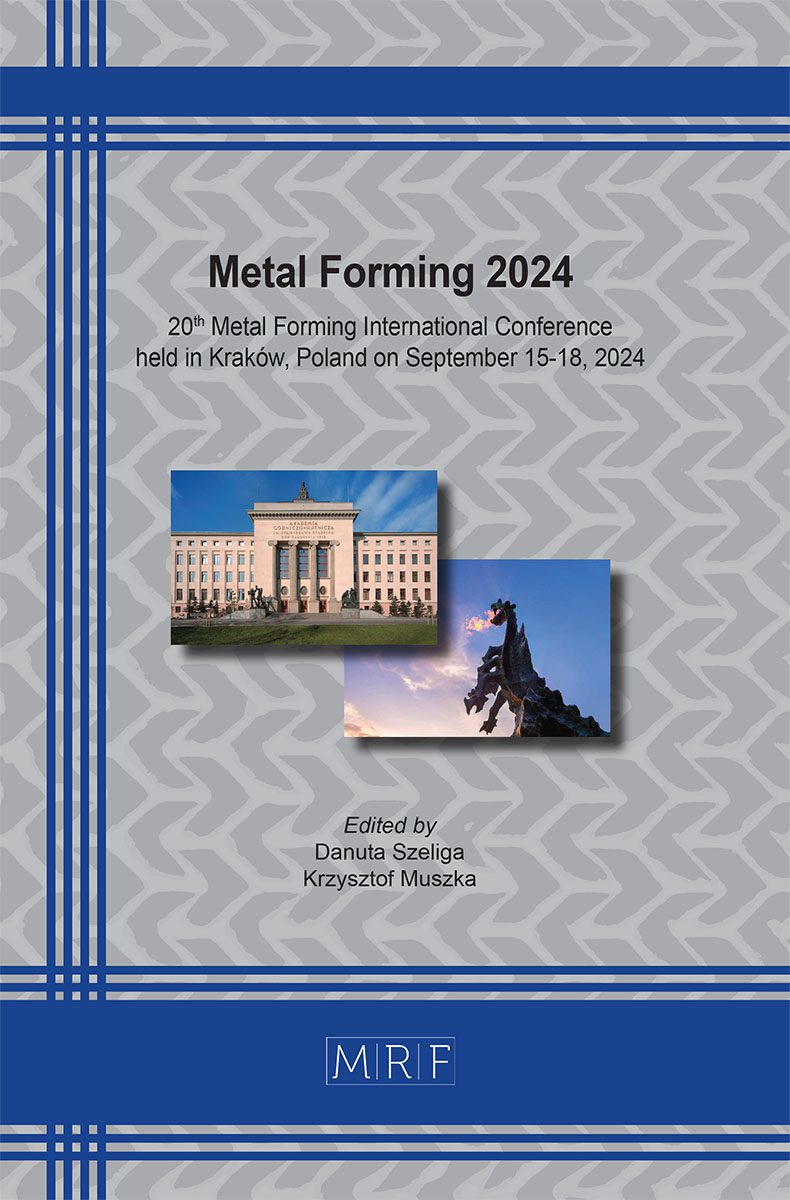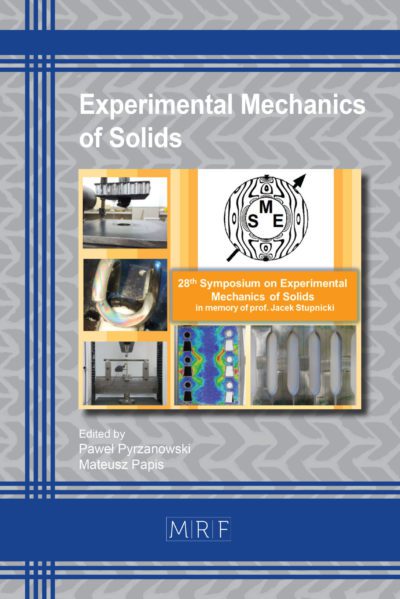–
Microstructure and texture evolution of Mg-Zn-Al-Ca (ZAX210) during groove rolling
STIRL Max, ULLMANN Madlen, PRAHL Ulrich
download PDFAbstract. This study introduces the ZAX210 magnesium alloy wire, produced using groove rolling. The starting material, initially extruded, was successfully rolled from 12.0 mm to 6.7 mm diameter in eight passes using square-oval grooves, finishing with an oval and round shape. High strain rates and an optimized rolling temperature of 265 °C were found beneficial, avoiding hot cracks and promoting recrystallization. Microstructural analysis using light and electron microscopy revealed a fully recrystallized, fine microstructure with uniform precipitate distribution. Texture development is being assessed with EBSD, where a strong dependence of the respective groove shape on the expression of the texture was observed. Mechanical properties of the final wire were determined, whereas Rp0.2 is 308 MPa, Rm is 337 MPa and A is 17.8 %.
Keywords
Microstructure, Magnesium, ZAX210, Groove Tolling
Published online 9/15/2024, 9 pages
Copyright © 2024 by the author(s)
Published under license by Materials Research Forum LLC., Millersville PA, USA
Citation: STIRL Max, ULLMANN Madlen, PRAHL Ulrich, Microstructure and texture evolution of Mg-Zn-Al-Ca (ZAX210) during groove rolling, Materials Research Proceedings, Vol. 44, pp 331-339, 2024
DOI: https://doi.org/10.21741/9781644903254-35
The article was published as article 35 of the book Metal Forming 2024
![]() Content from this work may be used under the terms of the Creative Commons Attribution 3.0 license. Any further distribution of this work must maintain attribution to the author(s) and the title of the work, journal citation and DOI.
Content from this work may be used under the terms of the Creative Commons Attribution 3.0 license. Any further distribution of this work must maintain attribution to the author(s) and the title of the work, journal citation and DOI.
References
[1] R.L. Doiphode, S.V.S. Narayana Murty, N. Prabhu, B.P. Kashyap, Effects of caliber rolling on microstructure and room temperature tensile properties of Mg–3Al–1Zn alloy, J. Magnes. Alloy. 1 (2013) 169–175. https://doi.org/10.1016/j.jma.2013.07.005
[2] J.H. Lee, B.J. Kwak, T. Kong, S.H. Park, T. Lee, Improved tensile properties of AZ31 Mg alloy subjected to various caliber-rolling strains, J. Magnes. Alloy. 7 (2019) 381–387. https://doi.org/10.1016/j.jma.2019.06.002
[3] A. Tripathi, S.V.S.N. Murty, P.R. Narayanan, Microstructure and texture evolution in AZ31 magnesium alloy during caliber rolling at different temperatures, J. Magnes. Alloy. 5 (2017) 340–347. https://doi.org/10.1016/j.jma.2017.07.001
[4] T. Mukai, H. Somekawa, T. Inoue, A. Singh, Strengthening Mg–Al–Zn alloy by repetitive oblique shear strain with caliber roll, Scripta Mater. 62 (2010) 113–116. https://doi.org/10.1016/j.scriptamat.2009.09.005
[5] T. Mukai, H. Somekawa, A. Singh, T. Inoue, Strengthening Mg-Al-Zn Alloy by Repetitive Oblique Shear Strain, in: W.H. Sillekens, S.R. Agnew, N.R. Neelameggham, S.N. Mathaudhu (Eds.), Magnesium Technology 2011, John Wiley & Sons, Inc., Hoboken, NJ, USA, 2011: pp. 211–214. https://doi.org/10.1002/9781118062029.ch40
[6] R.L. Doiphode, S.V.S.N. Murty, N. Prabhu, B.P. Kashyap, Grain growth in calibre rolled Mg–3Al–1Zn alloy and its effect on hardness, J. Magnes. Alloy. 3 (2015) 322–329. https://doi.org/10.1016/j.jma.2015.11.003
[7] H. Yu, D. Wang, Y. Liu, Y. Liu, L. Huang, B. Jiang, S. Park, W. Yu, F. Yin, Recrystallization mechanisms and texture evolution of AZ31 alloy by gradient caliber rolling, J. Mater. Res. Tech. 23 (2023) 611–626. https://doi.org/10.1016/j.jmrt.2023.01.044
[8] A. Stefanik, P. Szota, S. Mróz, T. Bajor, H. Dyja, Properties of the AZ31 Magnesium Alloy Round Bars Obtained in Different Rolling Processes / Własności Prętów Okrągłych Ze Stopu Magnezu AZ31 Otrzymanych W Różnych Procesach Walcowania, Arch. Metall. Mater. 60 (2015) 3001–3006. https://doi.org/10.1515/amm-2015-0479
[9] P. Adamyanets, M. Schmidtchen, R. Kawalla, Extension of the Freiberger Model of Spread for the Calculation of Material Flow during Rolling of Long Products to a New Material Group of Mg Alloys AZ31, AZ81, WE43, KEM 716 (2016) 677–684. https://doi.org/10.4028/www.scientific.net/KEM.716.677
[10] T. Kong, B.J. Kwak, J. Kim, J.H. Lee, S.H. Park, J.H. Kim, Y.H. Moon, H.S. Yoon, T. Lee, Tailoring strength-ductility balance of caliber-rolled AZ31 Mg alloy through subsequent annealing, J. Magnes. Alloy. 8 (2020) 163–171. https://doi.org/10.1016/j.jma.2019.11.005
[11] Y. Chino, Y. Nakaura, K. Ohori, A. Kamiya, M. Mabuchi, Mechanical properties at elevated temperature of a hot-deformed Mg–Al–Ca–Mn–Sr alloy, Mater. Sci. Eng. A 452–453 (2007) 31–36. https://doi.org/10.1016/j.msea.2006.12.118.
[12] M. Ullmann, K. Kittner, T. Henseler, A. Stöcker, U. Prahl, R. Kawalla, Development of new alloy systems and innovative processing technologies for the production of magnesium flat products with excellent property profile, Procedia Manuf. 27 (2019) 203–208. https://doi.org/10.1016/j.promfg.2018.12.065
[13] F. Bachmann, R. Hielscher, H. Schaeben, Texture Analysis with MTEX – Free and Open Source Software Toolbox, SSP 160 (2010) 63–68. https://doi.org/10.4028/www.scientific.net/SSP.160.63
[14] M. Moses, J. Luft, M. Ullmann, U. Prahl, R. Kawalla, Impact of Initial State during Calibre Rolling: Investigating Microstructure and Mechanical Properties of AZ80 Magnesium Alloy, MSF 941 (2018) 857–862. https://doi.org/10.4028/www.scientific.net/MSF.941.857














